Edible Residential Balconies in the Mediterranean Climate: Architectural Design Guidelines
Abstract
1. Introduction
1.1. Urban Agriculture’s Correlation with Urban Sustainability
1.2. Zero-Acreage Farming (Zfarming)
1.3. Balconies in the Mediterranean Region
1.4. Purpose of the Research
1.5. Research Gap
1.6. Research Questions
- (1)
- What key design guidelines should architects follow when designing edible balconies for residential apartment buildings in Mediterranean climates?
- (2)
- What are the main obstacles to designing edible balconies for residential apartment buildings within Mediterranean climates?
1.7. Research Contribution
1.8. Research Limitations
2. Materials and Methods
3. Results
3.1. Edible Balconies: Design Considerations
3.1.1. Open-Air Food Production
Container Gardening
Vertical Gardening
Raised Bed Gardening
3.1.2. Protected Cultivation (Lean-To and Mini Greenhouses)
3.1.3. Soilless Farming
3.2. Design Guidelines and Major Obstacles
3.3. Potential Food Yield and Approximate Cost
3.4. Edible Balconies and Rooftop Gardens: Similarities and Differences
3.5. Design Proposals
4. Discussion
4.1. Response to Research Questions
4.2. Future Research Directions
5. Conclusions
Funding
Data Availability Statement
Acknowledgments
Conflicts of Interest
References
- UN. World Population Prospects 2024: Summary of Results; United Nations: New York, NY, USA, 2024; p. 3. Available online: https://desapublications.un.org/publications/world-population-prospects-2024-summary-results (accessed on 5 January 2025).
- UN. World Population Prospects 2022: Summary of Results; United Nations: New York, NY, USA, 2022; p. 3. Available online: https://www.un.org/development/desa/pd/sites/www.un.org.development.desa.pd/files/wpp2022_summary_of_results.pdf (accessed on 5 January 2025).
- UN. World Urbanization Prospects: The 2018 Revision; United Nations: New York, NY, USA, 2019; p. 1. Available online: https://www.un.org/development/desa/pd/sites/www.un.org.development.desa.pd/files/files/documents/2020/Jan/un_2018_wup_report.pdf (accessed on 5 January 2025).
- Güneralp, B.; Reba, M.; Hales, B.U.; Wentz, E.A.; Seto, K.C. Trends in urban land expansion, density, and land transitions from 1970 to 2010: A global synthesis. Environ. Res. Lett. 2020, 15, 044015. [Google Scholar] [CrossRef]
- Bren d’Amour, C.; Reitsma, F.; Baiocchi, G.; Barthel, S.; Güneralp, B.; Erb, K.H.; Haberl, H.; Creutzig, F.; Seto, K.C. Future urban land expansion and implications for global croplands. Proc. Natl. Acad. Sci. USA 2017, 114, 8939–8944. [Google Scholar] [CrossRef]
- Riffat, S.; Powell, R.; Aydin, D. Future cities and environmental sustainability. Future Cities Environ. 2016, 2, 23. [Google Scholar] [CrossRef]
- Khan, R.; Aziz, Z.; Ahmed, V. Building Integrated Agriculture Information Modelling (BIAIM): An integrated approach towards urban agriculture. Sustain. Cities Soc. 2018, 37, 594–607. [Google Scholar] [CrossRef]
- Davis, K.F.; D’Odorico, P.; Rulli, M.C. Moderating diets to feed the future. Earth’s Future 2014, 2, 559–565. [Google Scholar] [CrossRef]
- Thebo, A.L.; Drechsel, P.; Lambin, E.F. Global assessment of urban and peri-urban agriculture: Irrigated and rainfed croplands. Environ. Res. Lett. 2014, 9, 114002. [Google Scholar] [CrossRef]
- El-Beltagy, A.; Madkour, M. Impact of climate change on arid lands agriculture. Agric. Food Secur. 2012, 1, 3. [Google Scholar] [CrossRef]
- Mendelsohn, R. The impact of climate change on agriculture in developing countries. J. Nat. Resour. Policy Res. 2008, 1, 5–19. [Google Scholar] [CrossRef]
- Yohannes, H. A Review on Relationship between Climate Change and Agriculture. J. Earth Sci. Clim. Change 2016, 7, 1000335. [Google Scholar]
- Kurukulasuriya, P.; Rosenthal, S. Climate Change and Agriculture: A Review of Impacts and Adaptations; World Bank: Washington, DC, USA, 2003; pp. 1–5. [Google Scholar]
- Malhi, G.S.; Kaur, M.; Kaushik, P. Impact of climate change on agriculture and Its mitigation strategies: A review. Sustainability 2021, 13, 1318. [Google Scholar] [CrossRef]
- Ignaciuk, A.; Mason-D’Croz, D. Modelling Adaptation to Climate Change in Agriculture. In OECD Food, Agriculture and Fisheries Papers; OECD Publishing: Paris, France, 2014; Volume 70. [Google Scholar] [CrossRef]
- UNCCD. Zero Net Land Degradation; UNCCD: Bonn, Germany, 2012; pp. 1–28. Available online: https://catalogue.unccd.int/58_Zero_Net_Land_Degradation.pdf (accessed on 13 January 2025).
- Abd-Elmabod, S.K.; Muñoz-Rojas, M.; Jordán, A.; Anaya-Romero, M.; Phillips, J.D.; Jones, L.; Zhang, Z.; Pereira, P.; Fleskens, L.; Van der Ploeg, M.; et al. Climate change impacts on agricultural suitability and yield reduction in a Mediterranean region. Geoderma 2020, 374, 114453. [Google Scholar] [CrossRef]
- Jat, M.L.; Bijay-Singh; Stirling, C.M.; Jat, H.S.; Tetarwal, J.P.; Jat, R.K.; Singh, R.; Lopez-Ridaura, S.; Shirsath, P.B. Soil processes and wheat cropping under emerging climate change scenarios in south Asia. Adv. Agron. 2018, 148, 111–171. [Google Scholar] [CrossRef]
- Carsan, S.; Stroebel, A.; Dawson, I.; Kindt, R.; Mbow, C.; Mowo, J.; Jamnadass, R. Can agroforestry option values improve the functioning of drivers of agricultural intensification in Africa? Curr. Opin. Environ. Sustain. 2014, 6, 35–40. [Google Scholar] [CrossRef]
- Rosegrant, M.W.; Zhu, T.; Msangi, S.; Sulser, T. Global scenarios for biofuels: Impacts and implications. Rev. Agric. Econ. 2008, 30, 495–505. [Google Scholar] [CrossRef]
- D’Ostuni, M.; Zaffi, L.; Appolloni, E.; Orsini, F. Understanding the complexities of Building-Integrated Agriculture. Can food shape the future built environment? Futures 2022, 144, 103061. [Google Scholar] [CrossRef]
- Eigenbrod, C.; Gruda, N. Urban vegetable for food security in cities. A review. Agron. Sustain. Dev. 2015, 35, 483–498. [Google Scholar] [CrossRef]
- Barthel, S.; Parker, J.; Ernstson, H. Food and green space in cities: A resilience lens on gardens and urban environmental movements. Urban Stud. 2013, 52, 1321–1338. [Google Scholar] [CrossRef]
- Leitgeb, F.; Schneider, S.; Vogl, C.R. Increasing food sovereignty with urban agriculture in Cuba. Agric. Hum. Values 2016, 33, 415–426. [Google Scholar] [CrossRef]
- Altieri, M.; Companioni, N.; Cañizares, K.; Murphy, C.; Rosset, P.; Bourque, M.; Nicholls, C. The greening of the “barrios”: Urban agriculture for food security in Cuba. Agric. Hum. Values 1999, 16, 131–140. [Google Scholar] [CrossRef]
- Fernandez, M. Urban agriculture in Cuba: 30 years of policy and practice. Urban Agric. Mag. 2017, 33, 41–44. [Google Scholar]
- McMichael, P. A food regime analysis of the ‘world food crisis’. Agric. Hum. Values 2009, 26, 281–295. [Google Scholar] [CrossRef]
- Conceição, P.; Mendoza, R.U. Anatomy of the global food crisis. Third World Q. 2009, 30, 1159–1182. [Google Scholar] [CrossRef]
- Dubbeling, M.; de Zeeuw, H.; Van Veenhuizen, R. Cities, Poverty and Food: Multi-Stakeholder Policy and Planning in Urban Agriculture; Practical Action Publishing: Rugby, UK, 2010; pp. 1–17. [Google Scholar]
- WFP. War in Ukraine Drives Global Food Crisis; WFP: Rome, Italy, 2022; pp. 1–8. Available online: https://www.wfp.org/publications/war-ukraine-drives-global-food-crisis-0 (accessed on 10 January 2025).
- Filho, W.L.; Fedoruk, M.; Eustachio, J.H.P.P.; Barbir, J.; Lisovska, T.; Lingos, A.; Baars, C. How the war in Ukraine affects food security. Foods 2023, 12, 3996. [Google Scholar] [CrossRef]
- Ben Hassen, T.; El Bilali, H. Impacts of the Russia-Ukraine war on global food security: Towards more sustainable and resilient food systems? Foods 2022, 11, 2301. [Google Scholar] [CrossRef] [PubMed]
- Kvasha, S.; Andrei, P.; Mancini, M.C.; Vakulenko, V. Food security in Ukraine today’s conditions. Int. J. Food Sci. Nutr. 2024, 75, 622–636. [Google Scholar] [CrossRef]
- FAO. Impact of the Ukraine-Russia Conflict on Global Food Security and Related Matters Under the Mandate of the Food and Agriculture Organization of the United Nations (FAO); FAO: Rome, Italy, 2022; Available online: https://openknowledge.fao.org/server/api/core/bitstreams/dc893b4f-7675-49ea-aff2-b2d9fa1cb123/content (accessed on 10 January 2025).
- Berkhout, P. The impact of the war in Ukraine on food security. EuroChoices 2022, 21, 50–51. [Google Scholar] [CrossRef]
- FAO. Feeding the World in 2050; FAO: Rome, Italy, 2009; Available online: https://www.fao.org/4/k6021e/k6021e.pdf (accessed on 12 January 2025).
- Ackerman, K.; Conard, M.; Culligan, P.; Plunz, R.; Sutto, M.P.; Whittinghill, L. Sustainable food systems for future cities: The potential of urban agriculture. Econ. Soc. Rev. 2014, 45, 189–206. [Google Scholar]
- Thomaier, S.; Specht, K.; Henckel, D.; Dierich, A.; Siebert, R.; Freisinger, U.B.; Sawicka, M. Farming in and on urban buildings: Present practice and specific novelties of Zero-Acreage Farming (ZFarming). Renew. Agric. Food Syst. 2014, 30, 43–54. [Google Scholar] [CrossRef]
- Orsini, F.; Kahane, R.; Nono-Womdim, R.; Gianquinto, G. Urban agriculture in the developing world: A review. Agron. Sustain. Dev. 2013, 33, 695–720. [Google Scholar] [CrossRef]
- Astee, L.Y.; Kishnani, N.T. Building integrated agriculture: Utilising rooftops for sustainable food crop cultivation in Singapore. J. Green Build. 2010, 5, 105–113. [Google Scholar] [CrossRef]
- Specht, K.; Siebert, R.; Hartmann, I.; Freisinger, U.B.; Sawicka, M.; Werner, A.; Thomaier, S.; Henckel, D.; Walk, H.; Dierich, A. Urban agriculture of the future: An overview of sustainability aspects of food production in and on buildings. Agric. Hum. Values 2014, 31, 33–51. [Google Scholar] [CrossRef]
- Mougeot, L.J.A. Urban Agriculture: Definition, Presence, Potentials and Risks, and Policy Challenges; International Development Research Centre: Ottawa, ON, Canada, 2000; pp. 1–41. Available online: https://idl-bnc-idrc.dspacedirect.org/server/api/core/bitstreams/a0cf4b0d-b96c-4124-a1de-f006d4a97f00/content (accessed on 15 January 2025).
- Cerón-Palma, I.; Sanyé-Mengual, E.; Oliver-Solà, J.; Montero, J.I.; Rieradevall, J. Barriers and opportunities regarding the implementation of rooftop Eco.Greenhouses (RTEG) in Mediterranean cities of Europe. J. Urban Technol. 2012, 19, 87–103. [Google Scholar] [CrossRef]
- FAO. The State of Food and Agriculture; FAO: Rome, Italy, 1996; Available online: https://www.fao.org/4/w1358e/w1358e.pdf (accessed on 15 January 2025).
- Azunre, G.A.; Amponsah, O.; Peprah, C.; Takyi, S.A.; Braimah, I. A review of the role of urban agriculture in the sustainable city discourse. Cities 2019, 93, 104–119. [Google Scholar] [CrossRef]
- Zezza, A.; Tasciotti, L. Urban agriculture, poverty and food security: Empirical evidence from a sample of developing countries. Food Policy 2010, 35, 265–273. [Google Scholar] [CrossRef]
- Lee-Smith, D. Cities feeding people: An update on urban agriculture in equatorial Africa. Environ. Urban 2010, 22, 483–499. [Google Scholar] [CrossRef]
- Hung, Y. East New York farms: Youth participation in community development and urban agriculture. Child. Youth Environ. 2004, 14, 56–85. [Google Scholar] [CrossRef]
- Lin, B.B.; Philpott, S.M.; Jha, S. The future of urban agriculture and biodiversity-ecosystem services: Challenges and next steps. Basic Appl. Ecol. 2015, 16, 189–201. [Google Scholar] [CrossRef]
- Gill, S.E.; Handley, J.F.; Ennos, A.R.; Pauleit, S. Adapting cities for climate change: The role of the green infrastructure. Built Environ. 2007, 33, 115–133. [Google Scholar] [CrossRef]
- Xiao, Q.; McPherson, E.G. Rainfall interception by Santa Monica’s municipal urban forest. Urban Ecosyst. 2002, 6, 291–302. [Google Scholar] [CrossRef]
- Brock, A. Room to Grow: Participatory Landscapes and Urban Agriculture at NYU; New York University: New York, NY, USA, 2008; Available online: https://wildgreenyonder.wordpress.com/wp-content/uploads/2008/09/room_to_grow.pdf (accessed on 19 February 2025).
- Yeang, K.; Guerra, M. Building integrated food production. Archit. Des. 2008, 78, 128–131. [Google Scholar] [CrossRef]
- Drescher, A.W. Food for the cities: Urban agriculture in developing countries. ISHS Acta Hortic. 2004, 643, 227–231. [Google Scholar] [CrossRef]
- Ukhurebor, K.E.; Adetunji, C.O.; Olugbemi, O.T.; Nwankwo, W.; Olayinka, A.S.; Umezuruike, C.; Hefft, D.I. Precision agriculture: Weather forecasting for future farming. In AI, Edge and IoT-Based Smart Agriculture; Abraham, A., Dash, S., Rodrigues, J.J.P.C., Acharya, B., Pani, S.K., Eds.; Elsevier: London, UK, 2022; pp. 101–121. [Google Scholar] [CrossRef]
- Alon-Mozes, T.; Eizenberg, E. Mediterranean urban agriculture. In Routledge Handbook of Landscape and Food; Zeunert, J., Waterman, T., Eds.; Routledge: London, UK, 2018; pp. 185–196. [Google Scholar]
- Mitchell, A. The Edible Balcony: Growing Fresh Produce in Small Spaces; Rodale: New York, NY, USA, 2012; pp. 8–35. [Google Scholar]
- Ruppenthal, R.J. Fresh Food from Small Spaces: The Square Inch Gardener’s Guide to Year-Round Growing, Fermenting, and Sprouting; Chelsea Green Publishing Company: White River Junction, VT, USA, 2008; pp. 11–53. [Google Scholar]
- Jang, Y.; Jeong, S.J.; Han, K.S.; Lee, S.M.; Suh, J.N.; Kim, K.J. Light intensity and lettuce growth in an apartment balcony affected by the direction of balcony. J. Korean Soc. People Plants Environ. 2017, 20, 465–474. [Google Scholar] [CrossRef]
- Mladenović, E.; Lakićević, M.; Pavlović, L.; Hiel, K.; Padejčev, J. Opportunities and benefits of green balconies and terraces in urban conditions. Contemp. Agric. Serbian J. Agric. Sci. 2017, 66, 38–45. [Google Scholar] [CrossRef]
- Morrison, S.; Sweet, R. Garden Up: Smart Vertical Gardening for Small and Large Spaces; Cool Springs Press: Minneapolis, MN, USA, 2011; pp. 10–114. [Google Scholar]
- Espiritu, K. Field Guide to Urban Gardening: How to Grow Plants, No Matter Where You Live; Cool Springs Press: Minneapolis, MN, USA, 2019; pp. 36–290. [Google Scholar]
- Nolan, T. Raised Bed Gardening: A Complete Beginners Guide; New Shoe Press: Beverly, MA, USA, 2023; pp. 8–46. [Google Scholar]
- Nagase, A.; Lundholm, J. Container gardens: Possibilities and challenges for environmental and social benefits in cities. J. Living Archit. 2021, 8, 1–19. [Google Scholar] [CrossRef]
- Relf, D. Vegetable Gardening in Containers; Virginia Cooperative Extension: Blacksburg, VA, USA, 2015; Available online: https://www.pubs.ext.vt.edu/content/dam/pubs_ext_vt_edu/426/426-336/SPES-255.pdf (accessed on 18 February 2025).
- Hart, R.M. Vertical Vegetables & Fruit: Creative Gardening Techniques for Growing Up in Small Spaces; Storey Publishing: North Adams, MA, USA, 2011; pp. 10–84. [Google Scholar]
- Walliser, J. Container Gardening Complete: Creative Projects for Growing Vegetables and Flowers in Small Spaces; Quarto Publishing: Minneapolis, MN, USA, 2017; pp. 9–163. [Google Scholar]
- Wylie, T. Container Gardening for Beginners: A Guide to Growing Your Own Vegetables, Fruits, Herbs, and Edible Flowers; Rockridge Press: Emeryville, CA, USA, 2021; pp. 11–68. [Google Scholar]
- Moss, W. Any Size, Anywhere Edible Gardening: The No Yard, No Time, No Problem Way to Grow Your Own Food; Cool Springs Press: Minneapolis, MN, USA, 2012; pp. 23–69. [Google Scholar]
- Dobbs, L.; Halpin, A. Container Vegetable Gardening: Growing Crops in Pots in Every Space; Fox Chapel Publishing: Selsey, UK, 2012; pp. 15–182. [Google Scholar]
- Greutink, V. Edible Paradise: How to Grow Herbs, Flowers, and Veggies in Any Space; Permanent Publications: Portsmouth, UK, 2019; pp. 1–102. [Google Scholar]
- Vanheems, B. Grow Veg: The Beginner’s Guide to Easy Vegetable Gardening; Storey Publishing: North Adams, MA, USA, 2021; pp. 17–366. [Google Scholar]
- Peacock, P. Patio Produce: How to Cultivate A lot of Home-grown Vegetables from The Smallest Possible Space; Spring Hill: Oxford, UK, 2009; pp. 2–4. [Google Scholar]
- Halsall, L. Small Plot Big Harvest; DK Publishing: New York, NY, USA, 2012; pp. 9–30. [Google Scholar]
- Abbott, C. The Everything Small-Space Gardening Book; Karen Cooper: Avon, MA, USA, 2012; pp. 10–116. [Google Scholar]
- Cook, W. Urban Gardening: How to Grow Food in Any City Apartment or Yard No Matter How Small; Vertical Gardening Group: New York, NY, USA, 2012; pp. 13–88. [Google Scholar]
- Andrychowicz, A. Vertical Vegetables: Simple Projects that Deliver More Yield in Less Space; Cool Springs Press: Minneapolis, MN, USA, 2018; pp. 11–185. [Google Scholar]
- Relf, D. Container Gardening; Virginia Cooperative Extension: Blacksburg, VA, USA, 2000; Available online: https://vtechworks.lib.vt.edu/server/api/core/bitstreams/2debc0c1-a664-49a7-a2a9-731337b88c77/content (accessed on 16 February 2025).
- Durham, R.; Saha, S.; Strang, J.; Williams, M.A.; Wright, S.; Bessin, R.; Seebold, K.W.; Ward, N. Home Vegetable Gardening in Kentucky; Agriculture and Natural Resources Publications: Lexington, KY, USA, 2014; Available online: https://publications.ca.uky.edu/files/ID128.pdf (accessed on 18 February 2025).
- Nardozzi, C. Container gardening. In Gardening Complete: How to Best Grow Vegetables, Flowers, and Other Outdoor Plants; Trandem, B., Childers, K., Eds.; Cool Springs Press: Minneapolis, MN, USA, 2018; pp. 604–648. [Google Scholar]
- Richardson, F. Small-Space Container Gardens: Transform Your Balcony, Porch, or Patio with Fruits, Flowers, Foliage & Herbs; Timber Press: London, UK, 2012; pp. 17–163. [Google Scholar]
- Bellamy, A. Small-Space Vegetable Gardens: Growing Great Edibles in Containers, Raised Beds, and Small Plots; Timber Press: London, UK, 2010; pp. 10–131. [Google Scholar]
- Pennington, A. Apartment Gardening: Plants, Projects and Recipes for Growing Food in Your Urban Home; Sasquatch Books: Seattle, WA, USA, 2011; pp. 19–97. [Google Scholar]
- Sarkar, T. Grow All You Can Eat in 3 Square Feet; DK Publishing: New York, NY, USA, 2015; pp. 12–94. [Google Scholar]
- Tullock, J. Grow Food at Home: Simple Methods for Small Spaces; The Countryman Press: Woodstock, VT, USA, 2020; pp. 9–57. [Google Scholar]
- Pennington, A. Tiny Space Gardening: Growing Vegetables, Fruits, and Herbs in Small Outdoor Spaces; Sasquatch Books: Seattle, WA, USA, 2022; pp. 22–35. [Google Scholar]
- Hand, C. Urban Gardening; Lerner Publishing Group: Minneapolis, MN, USA, 2016; pp. 16–50. [Google Scholar]
- Hentges, C.; Dunn, B.; Layman, K. Container Gardening; Oklahoma Cooperative Extension Service: Stillwater, OK, USA, 2019; Available online: https://pods.okstate.edu/fact-sheets/HLA-6458pod.pdf (accessed on 16 February 2025).
- James, T.; Lott, D. Container Vegetable Gardening; University of Nebraska: Lincoln, NE, USA, 2015; Available online: https://digitalcommons.unl.edu/cgi/viewcontent.cgi?article=1011&context=extfacpub (accessed on 18 February 2025).
- Palmer, I. The Balcony Gardener: Creative Ideas for Small Spaces; CICO Books: New York, NY, USA, 2012; pp. 11–98. [Google Scholar]
- Johns, J. Vertical Gardening: A Complete Guide to Growing Food, Herbs, and Flowers in Small Spaces; Ground Swell Books: Nashville, TN, USA, 2012; pp. 15–100. [Google Scholar]
- Haase, J. Balcony Gardening: Growing Herbs and Vegetables in a Small Urban Space; Balcony Books: Toronto, ON, Canada, 2013; pp. 10–77. [Google Scholar]
- Trail, G. Easy Growing: Organic Herbs and Edible Flowers from Small Spaces; Clarkson Potter: New York, NY, USA, 2012; pp. 20–140. [Google Scholar]
- Greene, N. Vertical Gardening: More Garden in Less Space; Speedy Publishing: Newark, DE, USA, 2014; pp. 8–24. [Google Scholar]
- Wise, B. Container Gardening for All Seasons: Enjoy Year-Round Color with 101 Designs; Cool Springs Press: Minneapolis, MN, USA, 2012; pp. 9–11. [Google Scholar]
- Fisher, S. Growing Up the Wall: How to Grow Food in Vertical Places, on Roofs and in Small Spaces; Green Books: Exeter, UK, 2013; pp. 10–104. [Google Scholar]
- Nolan, T. Raised Bed Revolution: Build It, Fill It, Plant It… Garden Anywhere! Cool Springs Press: Minneapolis, MN, USA, 2016; pp. 7–356. [Google Scholar]
- McLaughlin, C. Vertical Vegetable Gardening: Discover the Many Benefits of Growing Your Vegetables and Fruit Up Instead of Out; Alpha: New York, NY, USA, 2013; pp. 4–143. [Google Scholar]
- Johanson, M. Trellises, Planters & Raised Beds: 50 Easy, Unique, and Useful Projects You Can Make with Common Tools and Materials; Cool Springs Press: Minneapolis, MN, USA, 2013; pp. 16–350. [Google Scholar]
- Allaway, Z.; Leendertz, L. How To Grow Practically Everything; Dorling Kindersley Limited: London, UK, 2010; pp. 12–135. [Google Scholar]
- McGuinness, J. Micro Food Gardening: Project Plans and Plants for Growing Fruits and Veggies in Tiny Spaces; Cool Spring Press: Minneapolis, MN, USA, 2021; pp. 33–82. [Google Scholar]
- Harrison, J. Vegetable, Fruit and Herb Growing in Small Spaces; Right Way: London, UK, 2010; pp. 19–32. [Google Scholar]
- Barrett, P. Container Gardening; Storey Publishing: North Adams, MA, USA, 1996; pp. 6–30. [Google Scholar]
- Schneebeli-Morrell, D. Grow Your Own Vegetables in Pots: 35 Ideas for Growing Vegetables, Fruits and Herbs in Containers; CICO Books: London, UK, 2009; p. 19. [Google Scholar]
- Tayobong, R.R.P.; Sanchez, F.C.; Apacionado, B.V.; Balladares, M.C.E.; Medina, N.G. Edible landscaping in the Philippines: Maximizing the use of small spaces for aesthetics and crop production. J. Dev. Sustain. Agric. 2013, 99, 91–99. [Google Scholar] [CrossRef]
- Soule, J.A. Watering and fertilizing. In Gardening Complete: How to Best Grow Vegetables, Flowers, and Other Outdoor Plants; Trandem, B., Childers, K., Eds.; Cool Springs Press: Minneapolis, MN, USA, 2018; pp. 162–193. [Google Scholar]
- Akeroyd, S. Kitchen Gardening for Beginners: A Simple Guide to Growing Fruits and Vegetables; DK Publishing: London, UK, 2013; pp. 28–66. [Google Scholar]
- Fell, D. Vertical Gardening: Grow Up, Not Out, for More Vegetables and Flowers in Much Less Space; Rodale: New York, NY, USA, 2011; pp. 7–201. [Google Scholar]
- Bartholomew, M. All New Square Foot Gardening; Cool Spring Press: Minneapolis, MN, USA, 2018; pp. 14–172. [Google Scholar]
- Soule, J.A. Vertical Gardening. In Gardening Complete: How to Best Grow Vegetables, Flowers, and Other Outdoor Plants; Trandem, B., Childers, K., Eds.; Cool Springs Press: Minneapolis, MN, USA, 2018; pp. 649–670. [Google Scholar]
- Coronado, S. Grow a Living Wall: Create Vertical Gardens with Purpose; Cool Springs Press: Minneapolis, MN, USA, 2015; pp. 7–148. [Google Scholar]
- Park, M. More Food from Small Spaces: Growing Denser, Deeper, Higher, Longer Gardens; Great River Books: Salt Lake City, UT, USA, 2013; pp. 50–51. [Google Scholar]
- Ischenko, A.; Shishkunova, D. Application of vertical gardening technology in high-rise construction. E3S Web Conf. 2021, 258, 09035. [Google Scholar] [CrossRef]
- Nolan, T. Raised Beds. In Gardening Complete: How to Best Grow Vegetables, Flowers, and Other Outdoor Plants; Trandem, B., Childers, K., Eds.; Cool Springs Press: Minneapolis, MN, USA, 2018; pp. 671–711. [Google Scholar]
- Frugé, A.D.; Byrd, S.H.; Melby, P.; Nagel, D. The economic and nutritive value of the raised bed home vegetable garden: A model for the southeastern United States. Food Stud. Interdiscip. J. 2014, 3, 1–9. [Google Scholar] [CrossRef]
- Akeroyd, S. Raised-Bed Gardening: How to Grow More in Less Space; The Taunton Press: Newtown, CT, USA, 2016; pp. 8–67. [Google Scholar]
- Hangan, A.M.R.; Cojocariu, M.; Dascalu, D.M.; Chelariu, E.L.; Stoleru, V. Ornamental vegetable garden design possibilities using modular raised beds. J. Appl. Life Sci. Environ. 2023, 56, 1–14. [Google Scholar] [CrossRef]
- Bradley, F.M. Building Raised Beds: Easy, Accessible Garden Space for Vegetables and Flowers; Storey Publishing: North Adams, MA, USA, 2015; pp. 15–112. [Google Scholar]
- Mitchell, S. Raised Bed Gardening; Oklahoma Cooperative Extension Fact Sheets: Stillwater, OK, USA, 2017; Available online: https://extension.okstate.edu/fact-sheets/raised-bed-gardening.html (accessed on 22 February 2025).
- Badji, A.; Benseddik, A.; Bensaha, H.; Boukhelifa, A.; Hasrane, I. Design, technology, and management of greenhouse: A review. J. Clean. Prod. 2022, 373, 133753. [Google Scholar] [CrossRef]
- Smith, S. Greenhouse Gardener’s Companion: Growing Food and Flowers in Your Greenhouse or Sunspace; Fulcrum Publishing: Denver, CO, USA, 1992; pp. 12–100. [Google Scholar]
- Marshall, R. The Greenhouse Gardener’s Manual; Timber Press: Portland, OR, USA, 2014; pp. 9–48. [Google Scholar]
- Edwards, J. Greenhouse Gardening: Step by Step to Growing Success; The Crowood Press: Ramsbury, UK, 1988; pp. 7–48. [Google Scholar]
- Palmstierna, I. Greenhouse Vegetable Gardening: Expert Advice on How to Grow Vegetables, Herbs, and Other Plants; Skyhorse Publishing: New York, NY, USA, 2007; pp. 14–313. [Google Scholar]
- Mongkon, S.; Thepa, S.; Namprakai, P.; Pratinthong, N. Cooling performance assessment of horizontal earth tube system and effect on planting in tropical greenhouse. Energy Convers. Manag. 2014, 78, 225–236. [Google Scholar] [CrossRef]
- Joudi, K.A.; Farhan, A.A. Greenhouse heating by solar air heaters on the roof. Renew. Energy 2014, 72, 406–414. [Google Scholar] [CrossRef]
- Kittas, C.; Katsoulas, N.; Bartzanas, T. Greenhouse climate control in Mediterranean greenhouses. Cuad. Estud. Agroaliment. (CEA) 2012, 89–114. Available online: https://publicacionescajamar.es/wp-content/uploads/2023/03/3-553.pdf (accessed on 2 March 2025).
- Chen, J.; Ma, Y.; Pang, Z. A mathematical model of global solar radiation to select the optimal shape and orientation of the greenhouses in southern China. Sol. Energy 2020, 205, 380–389. [Google Scholar] [CrossRef]
- Kalantari, F.; Tahir, O.M.; Lahijani, A.M.; Kalantari, S. A review of vertical farming technology: A guide for implementation of Building Integrated Agriculture in cities. Adv. Eng. Forum 2017, 24, 76–91. [Google Scholar] [CrossRef]
- Khan, S.; Purohit, A.; Vadsaria, N. Hydroponics: Current and future state of the art in farming. J. Plant Nutr. 2021, 44, 1515–1538. [Google Scholar] [CrossRef]
- Kumar, S.; Singh, M.; Yadav, K.K.; Singh, P.K. Opportunities and constraints in hydroponic crop production systems: A review. Environ. Conserv. J. 2021, 22, 401–408. [Google Scholar] [CrossRef]
- Gebreegziher, W.G. Soilless culture technology to transform vegetable farming, reduce land pressure and degradation in drylands. Cogent Food Agric. 2023, 9, 2265106. [Google Scholar] [CrossRef]
- Rajaseger, G.; Chan, K.L.; Tan, K.Y.; Ramasamy, S.; Khin, M.C.; Amaladoss, A.; Haribhai, P.K. Hydroponics: Current trends in sustainable crop production. Bioinformation 2023, 19, 925–938. [Google Scholar] [CrossRef]
- Gumisiriza, M.S.; Ndakidemi, P.A.; Mbega, E.R. A simplified non-greenhouse hydroponic system for small-scale soilless urban vegetable farming. MethodsX 2022, 9, 101882. [Google Scholar] [CrossRef] [PubMed]
- Sharma, S.; Lishika, B.; Shahi, A.; Kaushal, S. Hydroponics: The Potential to Enhance Sustainable Food Production in Non-Arable Areas. Curr. J. Appl. Sci. Technol. 2023, 42, 13–23. [Google Scholar] [CrossRef]
- Khatri, L.; Kunwar, A.; Bist, D.R. Hydroponics: Advantages and challenges in soilless farming. Big Data Agric. 2024, 6, 81–88. [Google Scholar] [CrossRef]
- Mir, Y.H.; Mir, S.; Ganie, M.A.; Shah, A.M.; Majeed, U.; Chesti, M.H.; Mansoor, M.; Irshad, I.; Javed, A.; Sadiq, S.; et al. Soilless farming: An innovative sustainable approach in agriculture. Pharma Innov. J. 2022, 11, 2663–2675. [Google Scholar]
- Pradhan, B.; Deo, B. Soilless farming—The next generation green revolution. Curr. Sci. 2019, 116, 728–732. [Google Scholar] [CrossRef]
- Maluin, F.N.; Hussein, M.Z.; Ibrahim, N.N.L.N.; Wayayok, A.; Hashim, N. Some emerging opportunities of nanotechnology development for soilless and microgreen farming. Agronomy 2021, 11, 1213. [Google Scholar] [CrossRef]
- Sardare, M.D.; Admane, S.V. A review on plant without soil—Hydroponics. Int. J. Res. Eng. Technol. 2013, 2, 299–304. [Google Scholar]
- Muhasin, H.J.; Gheni, A.Y.; Tajuddin, N.I.I.; Izni, N.A.; Jusoh, Y.Y.; Aziz, K.A. A systematic literature review for smart hydroponic system. Bull. Electr. Eng. Inform. 2024, 13, 656–664. [Google Scholar] [CrossRef]
- Jan, S.; Rashid, Z.; Ahngar, T.A.; Iqbal, S.; Naikoo, M.A.; Majeed, S.; Bhat, T.A.; Gul, R.; Nazir, I. Hydroponics—A Review. Int. J. Curr. Microbiol. Appl. Sci. 2020, 9, 1779–1787. [Google Scholar] [CrossRef]
- Atherton, H.R.; Li, P. Hydroponic cultivation of medicinal plants—Plant organs and hydroponic systems: Techniques and trends. Horticulturae 2023, 9, 349. [Google Scholar] [CrossRef]
- Puri, V.; Caplow, T. How to Grow Food in the 100% Renewable City: Building-Integrated Agriculture. In 100% Renewable: Energy Autonomy in Action; Droege, P., Ed.; Earthscan: London, UK, 2009; pp. 229–241. [Google Scholar]
- Cabrera, R.I.; Johnson, J.R. Fundamentals of Container Media Management: Part I; Cooperative Extension: New Brunswick, NJ, USA, 1995; Available online: https://njaes.rutgers.edu/fs812/ (accessed on 22 September 2025).
- University of Wisconsin Cooperative Extension. Growing a Tomato Plant in a Container; University of Wisconsin Cooperative Extension: Madison, WI, USA. Available online: https://marinette.extension.wisc.edu/files/2018/01/tomato-in-a-container_sr.pdf (accessed on 27 October 2025).
- University of Maryland Extension. Growing Tomatoes in a Home Garden; University of Maryland Extension: Cumberland, MD, USA, 2025; Available online: https://extension.umd.edu/resource/growing-tomatoes-home-garden/ (accessed on 27 October 2025).
- Whittinghill, L.J.; Goins, M.; Lucas, S. Market Yield of Relay Cropped Leafy Greens in Urban Agriculture Production Systems. HortScience 2025, 60, 1171–1179. [Google Scholar] [CrossRef]
- Payen, F.T.; Evans, D.L.; Falagán, N.; Hardman, C.A.; Kourmpetli, S.; Liu, L.; Marshall, R.; Mead, B.R.; Davies, J.A.C. How Much Food Can We Grow in Urban Areas? Food Production and Crop Yields of Urban Agriculture: A Meta-Analysis. Earth’s Future 2022, 10, e2022EF002748. [Google Scholar] [CrossRef]
- Shao, Y.; Zhou, Z.; Chen, H.; Zhang, F.; Cui, Y.; Zhou, Z. The potential of urban family vertical farming: A pilot study of Shanghai. Sustain. Prod. Consum. 2022, 34, 586–599. [Google Scholar] [CrossRef]
- Carrasco, G.; Fuentes-Peñailillo, F.; Manríquez, P.; Rebolledo, P.; Vega, R.; Gutter, K.; Urrestarazu, M. Enhancing Leafy Greens’ Production: Nutrient Film Technique Systems and Automation in Container-Based Vertical Farming. Agronomy 2024, 14, 1932. [Google Scholar] [CrossRef]
- Pastor-Arbulú, P.; Rodríguez-Delfín, A. Enhancing the growth, yield and physiological response of two lettuce (Lactuca sativa L.) cultivars through NFT system optimization. Front. Plant Sci. 2025, 16, 1639002. [Google Scholar] [CrossRef] [PubMed]
- Spofford, T.S. Invest in Vegetables: A Cost and Benefit Analysis of Container Grown Roma Tomatoes (Solanum lycopersicum cv. ‘Roma’) and Italian Basil (Ocimum basilicum cv. ‘Italian’). Bachelor’s Thesis, Oregon State University, Corvallis, OR, USA, 2021. Available online: https://ir.library.oregonstate.edu/downloads/7w62fh27p (accessed on 27 October 2025).
- Langellotto, G.A. What Are the Economic Costs and Benefits of Home Vegetable Gardens? J. Ext. 2014, 52, 14. [Google Scholar] [CrossRef]
- Jadrnicek, S.; Furman, Q.; Niemiera, A. Comparison of Raised Bed Methods, Materials, and Costs; Virginia Tech SPES-425NP; Virginia Cooperative Extension: Harrisonburg, VA, USA, 2022; Available online: https://www.pubs.ext.vt.edu/content/pubs_ext_vt_edu/en/SPES/spes-425/spes-425.html (accessed on 27 October 2025).
- Gould, D.; Caplow, T. Building-integrated agriculture: A new approach to food production. In Metropolitan Sustainability: Understanding and Improving the Urban Environment, Zeman, F., Ed.; Woodhead Publishing: Cambridge, UK, 2012; pp. 147–170. [Google Scholar] [CrossRef]
- Foley, J.A.; Ramankutty, N.; Brauman, K.A.; Cassidy, E.S.; Gerber, J.S.; Johnston, M.; Mueller, N.D.; O’Connell, C.; Ray, D.K.; West, P.C.; et al. Solutions for a cultivated planet. Nature 2011, 478, 337–342. [Google Scholar] [CrossRef] [PubMed]



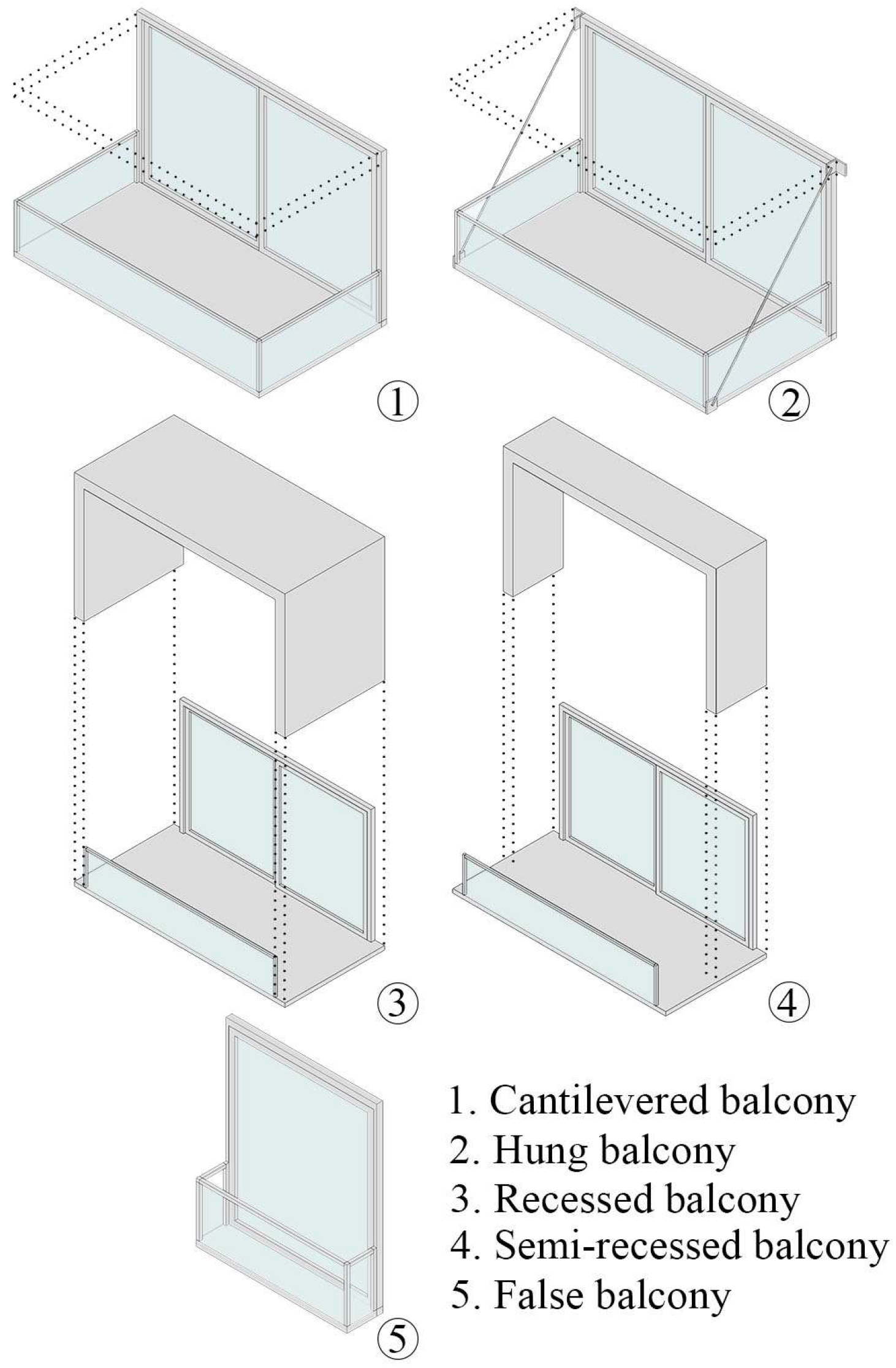
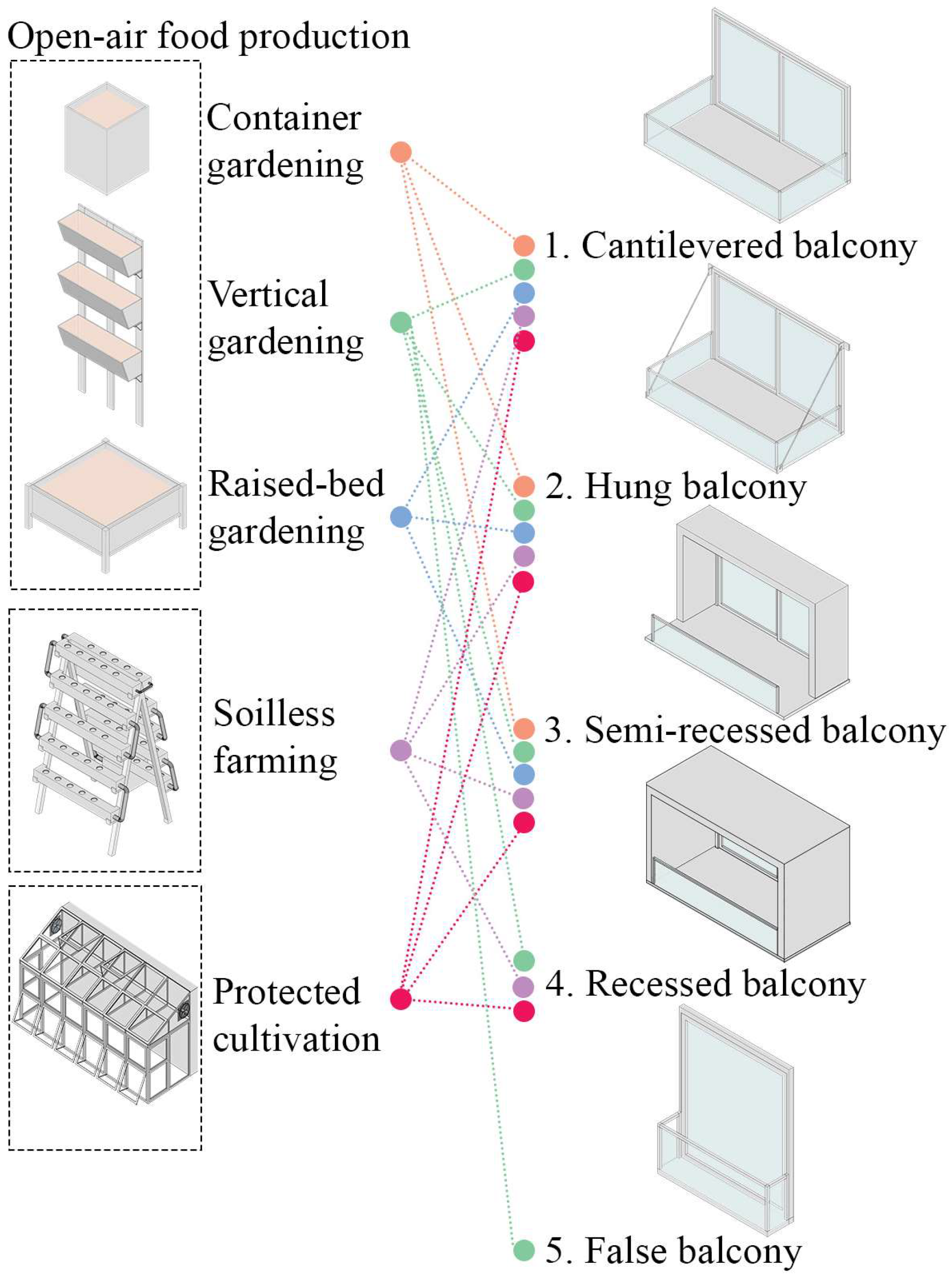





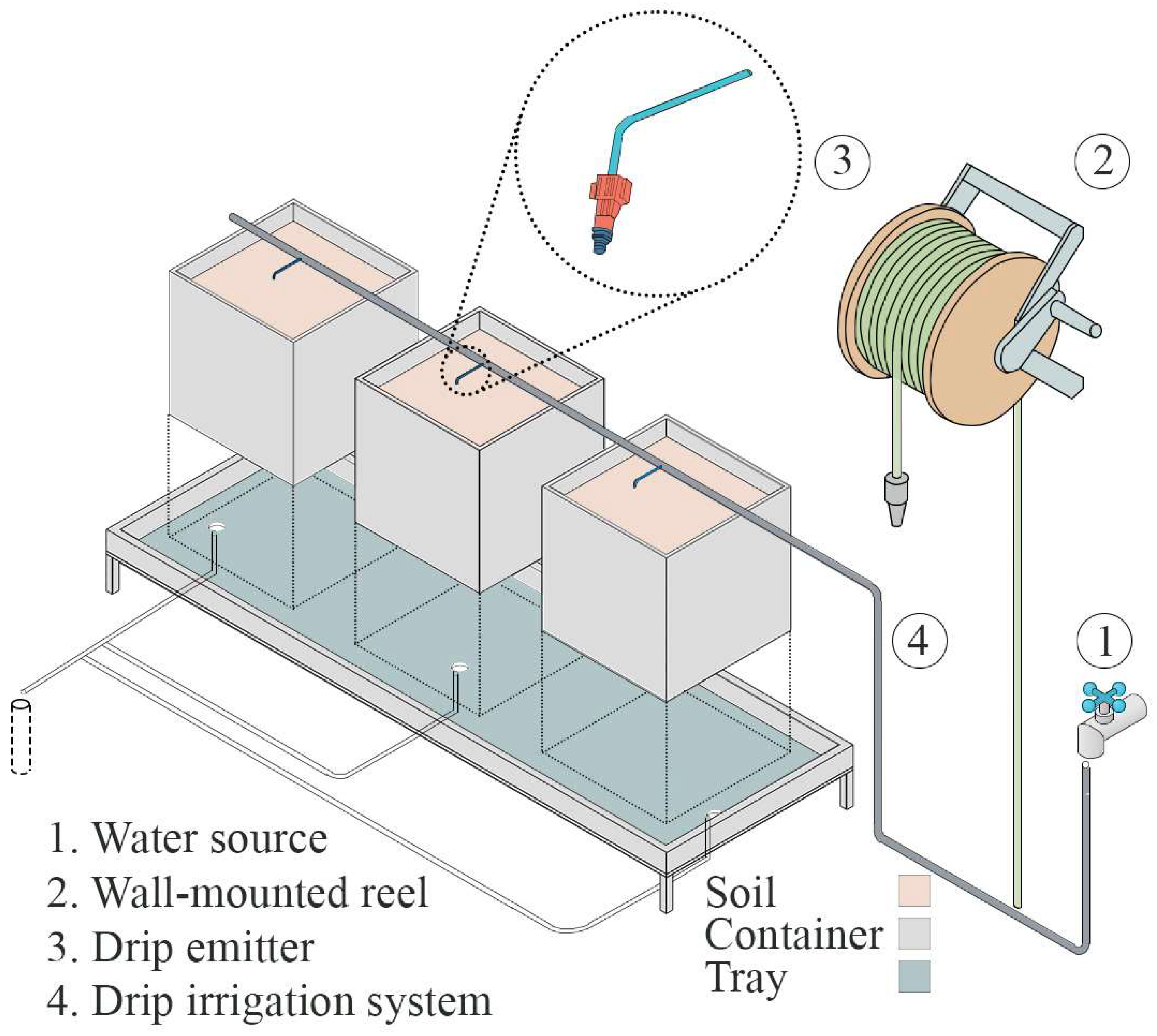
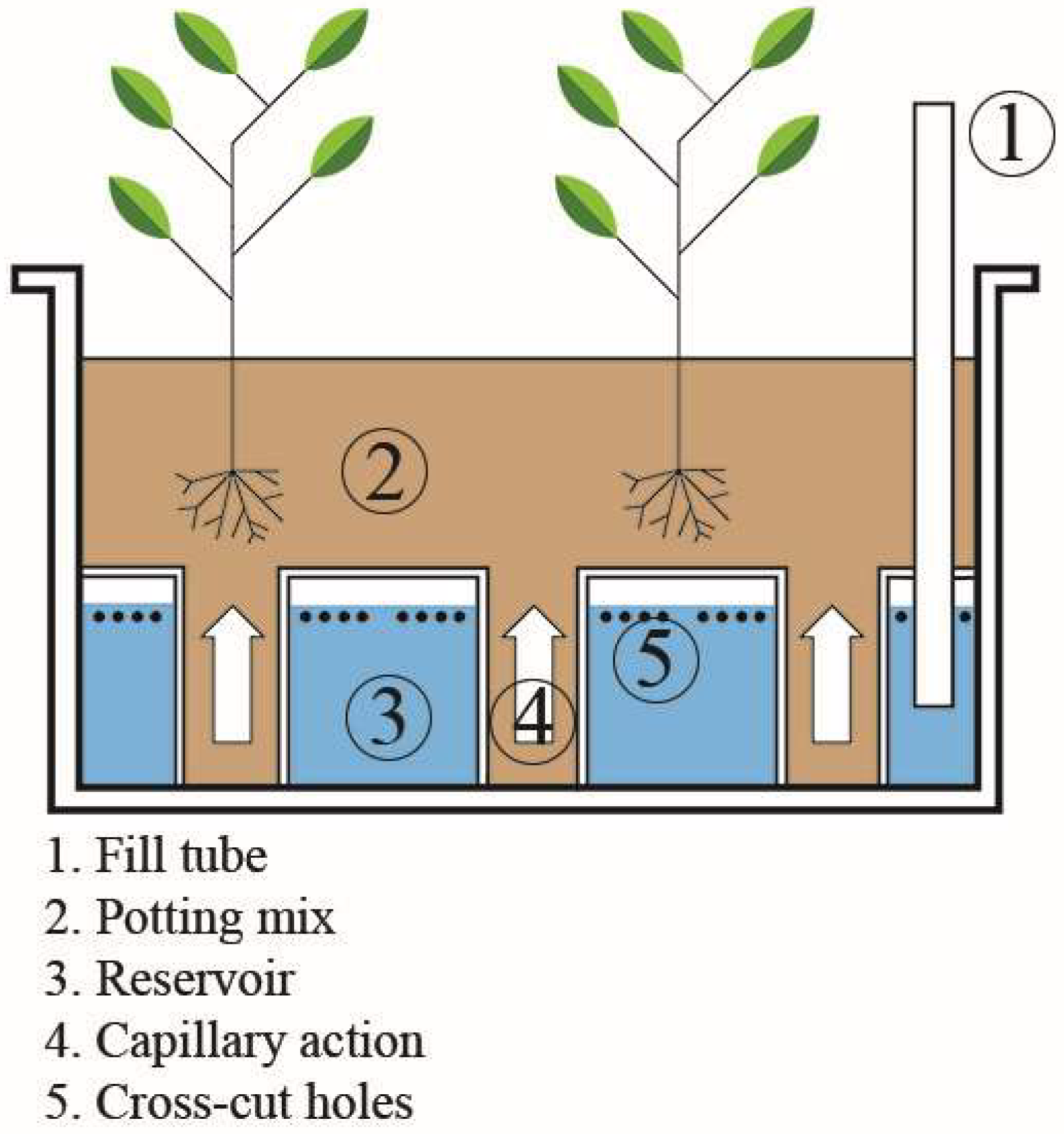


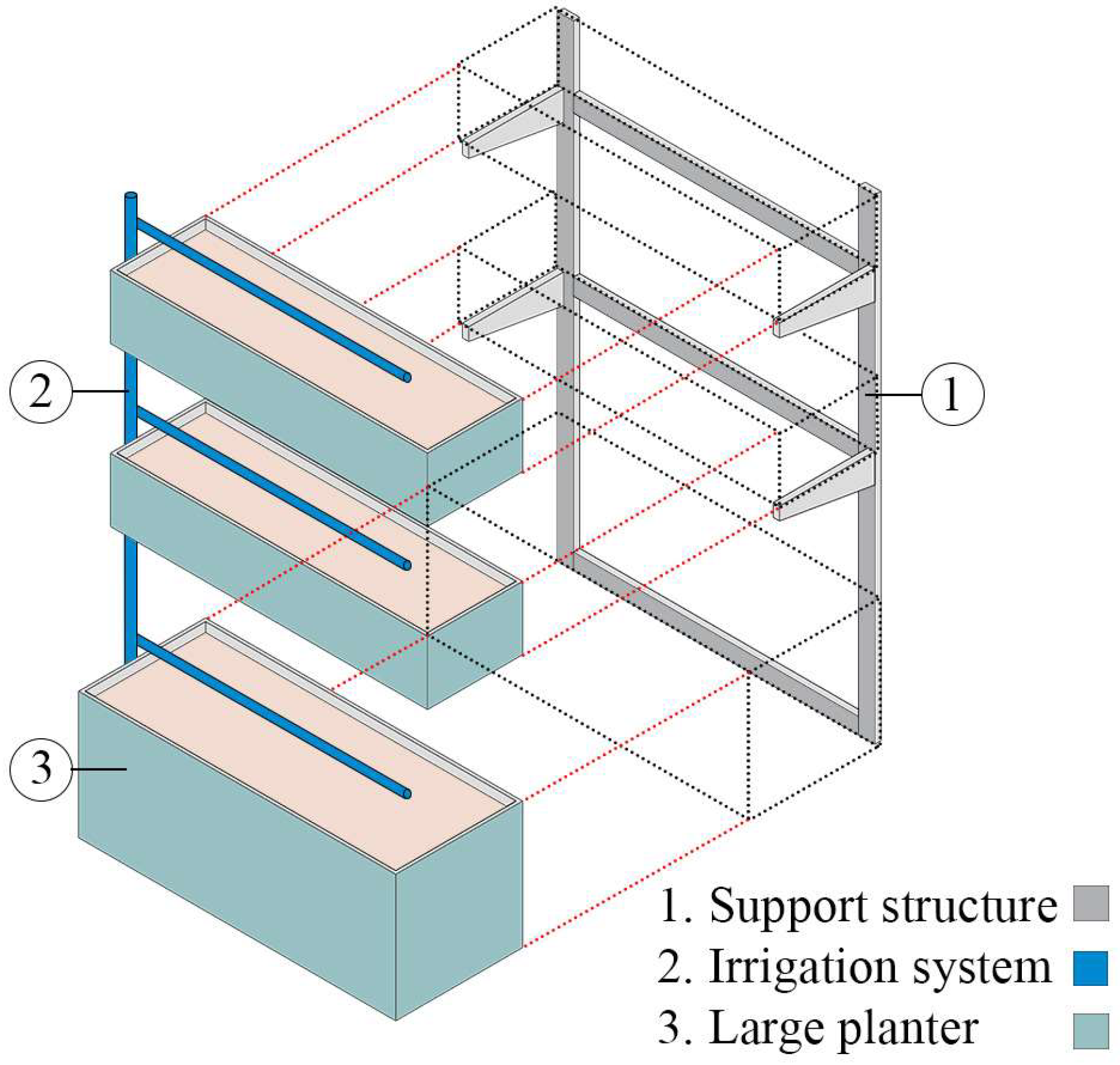

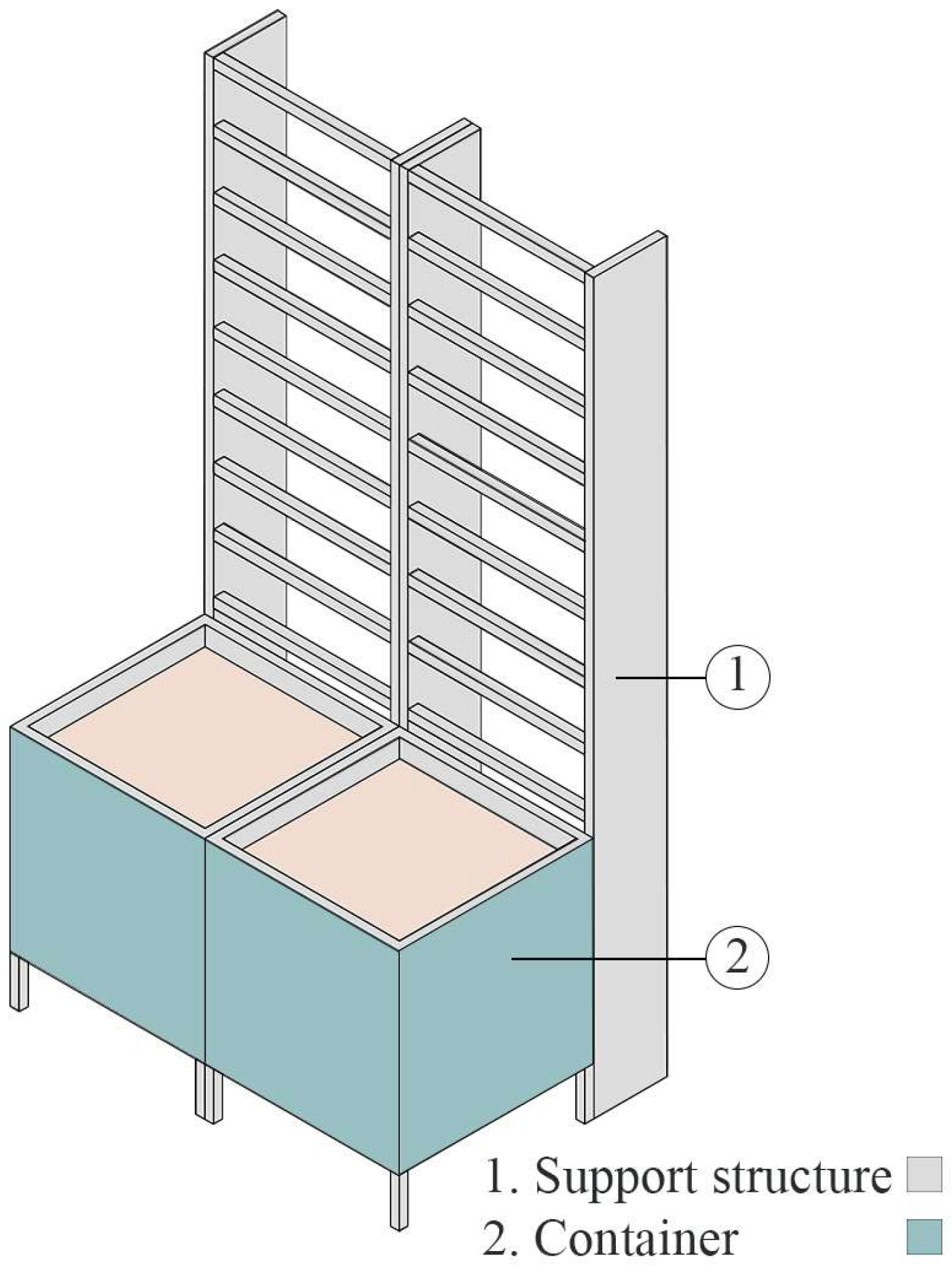



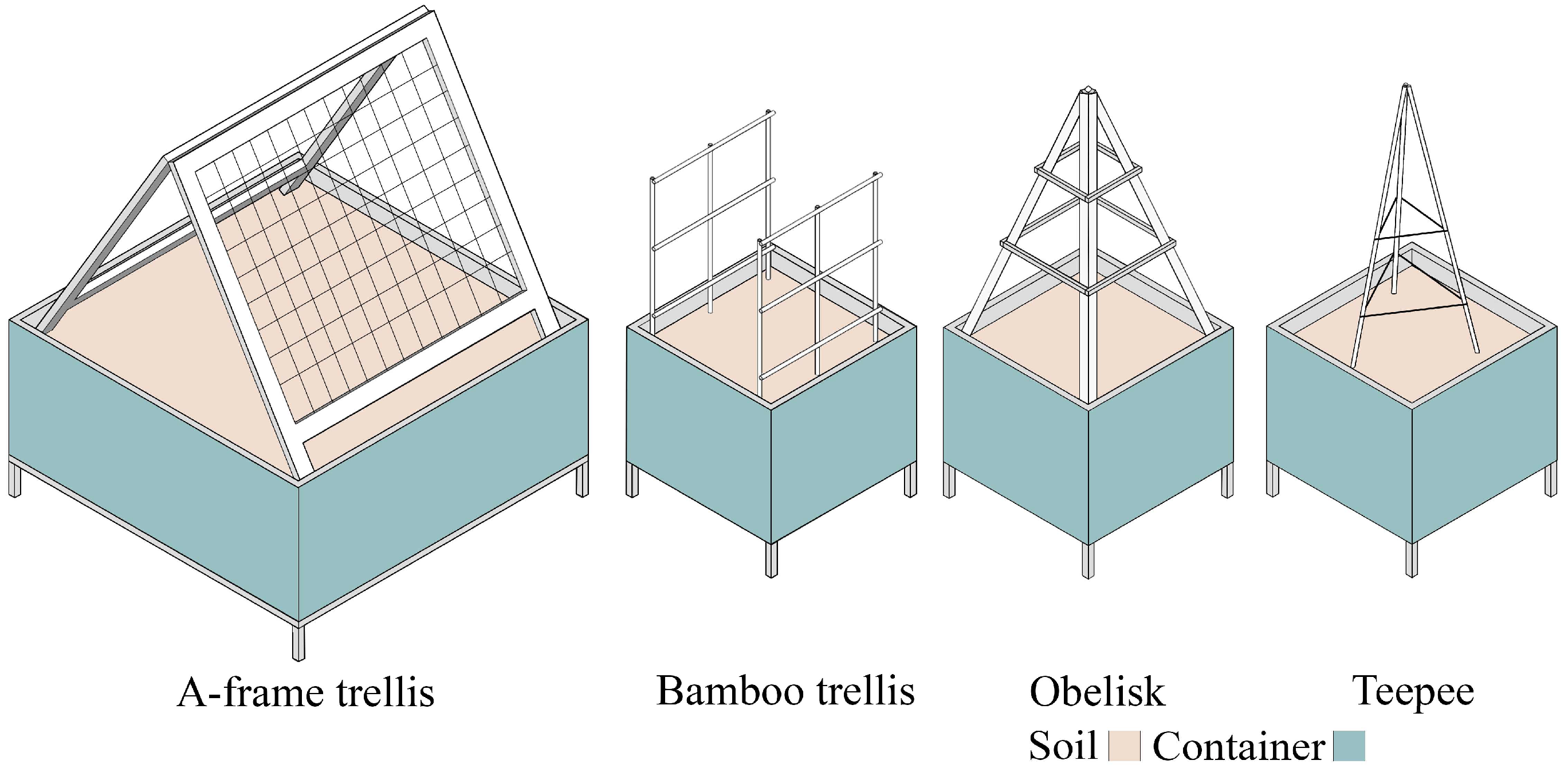
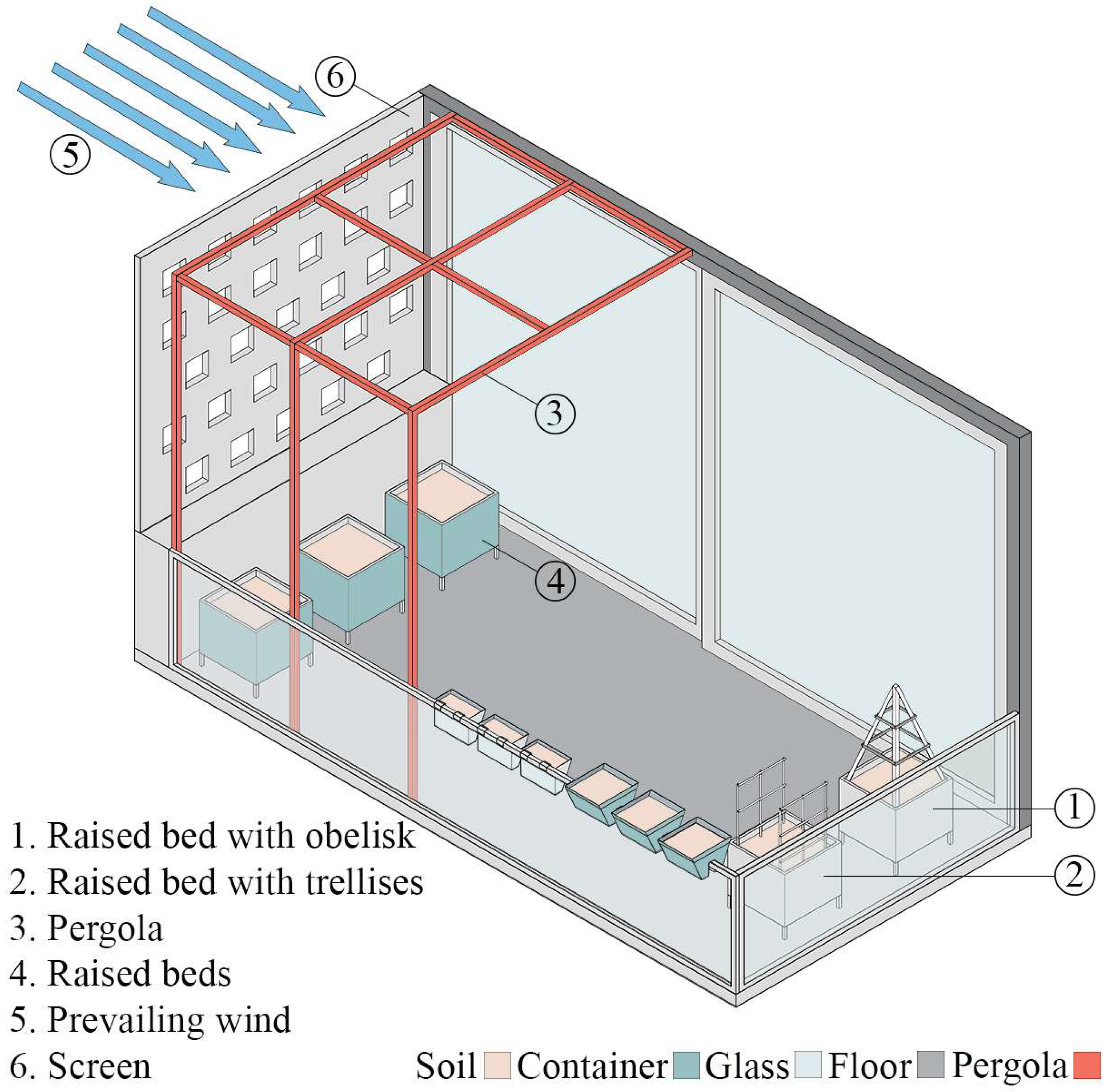



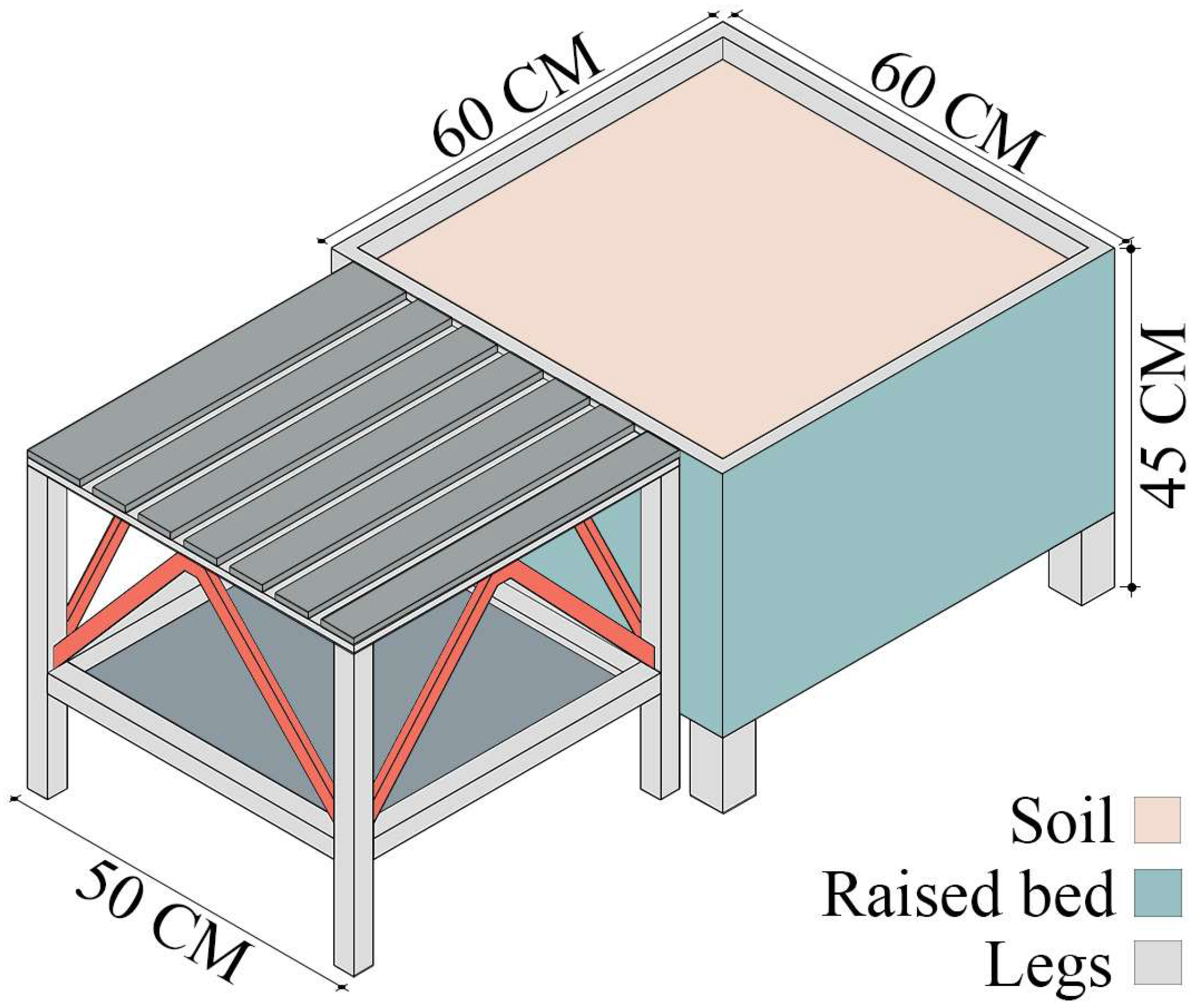

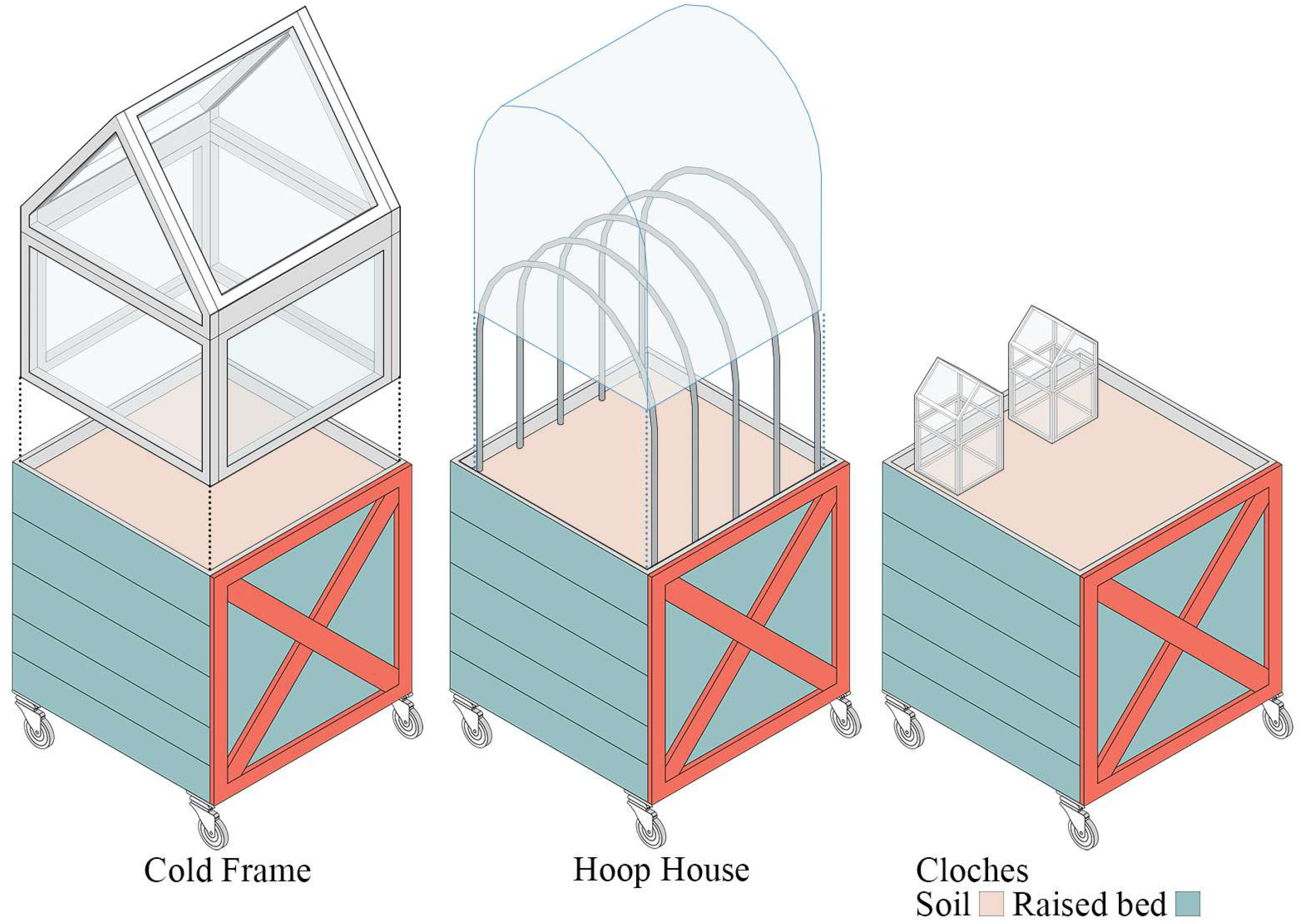





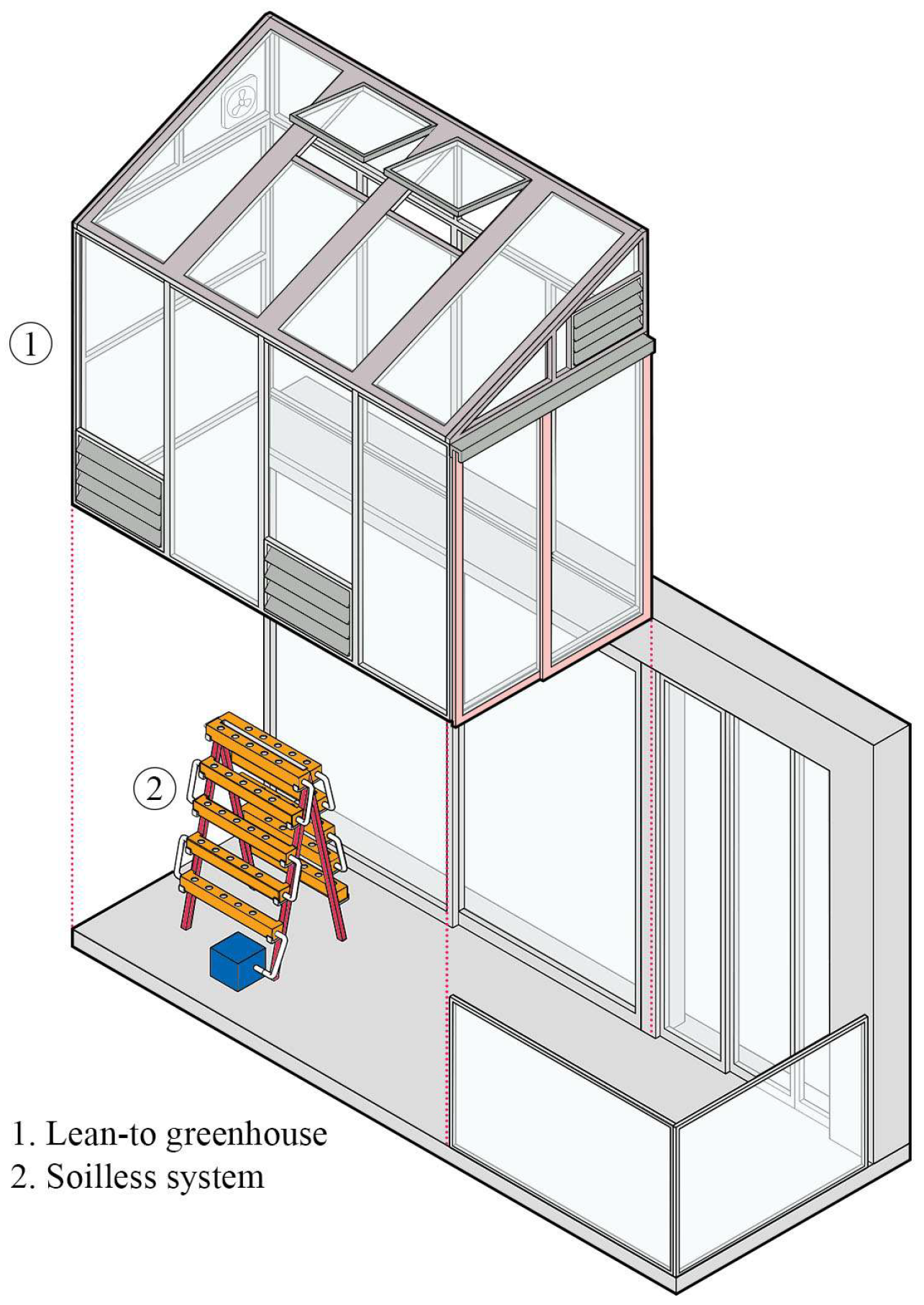
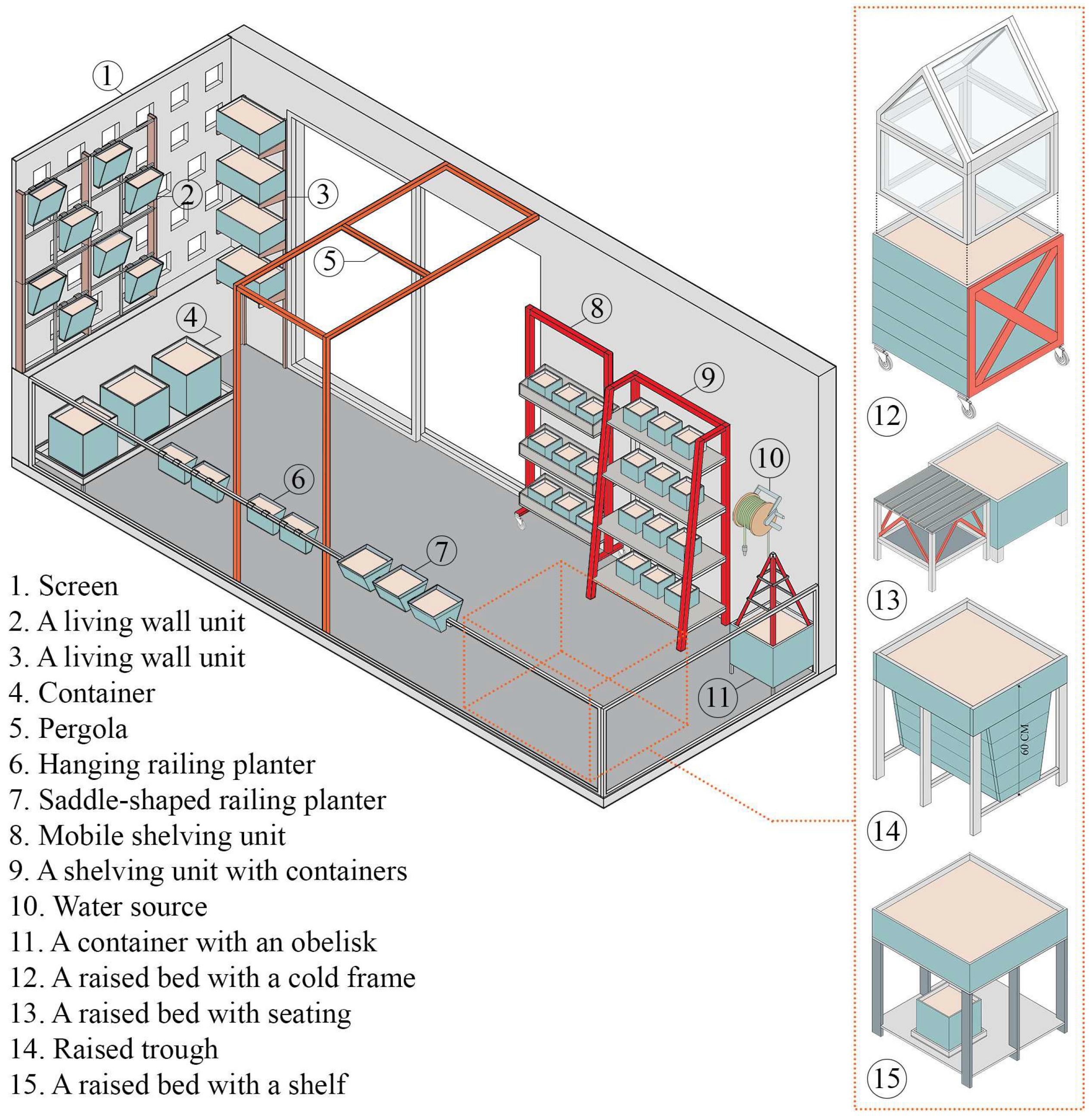
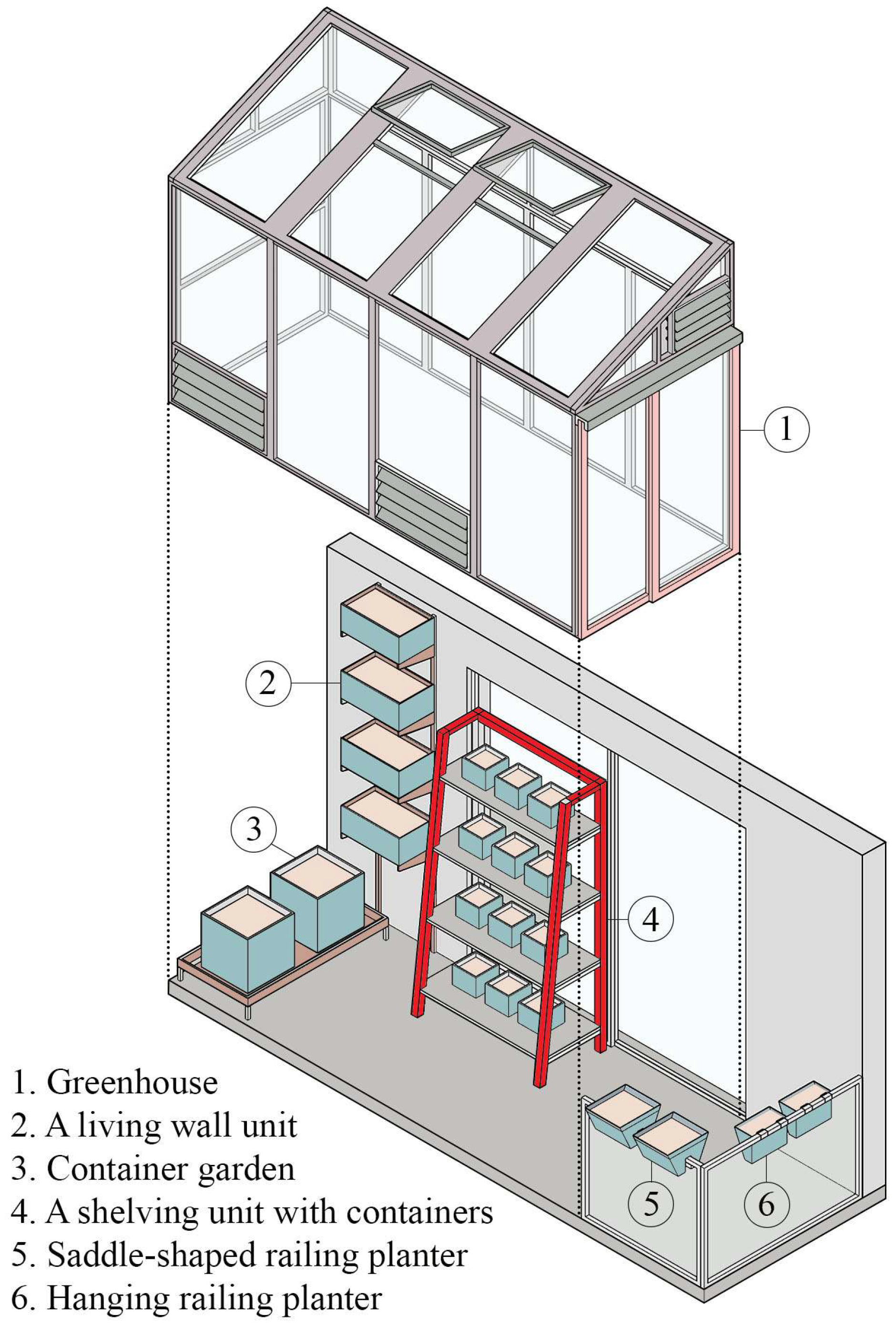
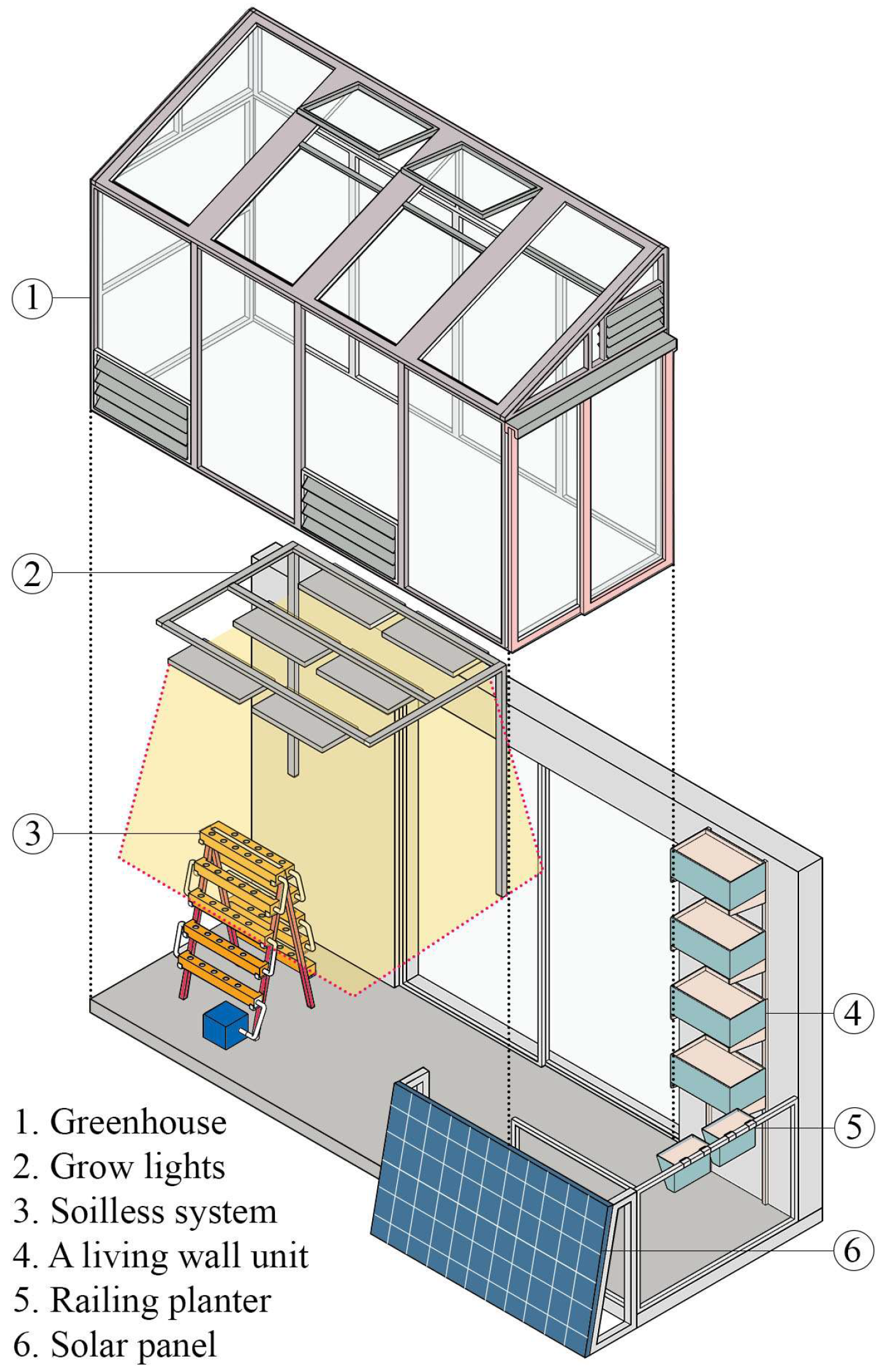
| Container/Raised Bed (cm) | Volume (m3) | Peat–Perlite (kg/lb) | Peat–Vermiculite (kg/lb) |
|---|---|---|---|
| Small container (20 × 20 × 20) | 0.0080 | 6.9 kg/15.3 lb | 8.0 kg/17.5 lb |
| Large container (40 × 40 × 40) | 0.0640 | 55.4 kg/122.0 lb | 63.6 kg/140.1 lb |
| Raised bed (120 × 120 × 30) | 0.4320 | 373.7 kg/823.8 lb | 429.0 kg/945.9 lb |
| Raised bed (45 × 45 × 45) | 0.0911 | 78.8 kg/173.8 lb | 90.5 kg/199.5 lb |
| Proposed Key Design Guidelines | |
|---|---|
| Orientation of the balcony | Consider balconies facing south and southeast. |
| Sun exposure | Vegetables, fruits, and herbs require a minimum of six to eight hours of sunlight each day. |
| Artificial lighting | Balconies with limited natural sunlight can be equipped with grow lights. |
| Sufficient space | Balconies should have sufficient space for designing an edible garden. |
| Access pathways | Primary access paths should be clearly defined. |
| Balcony structure | The balcony structure must have adequate load-bearing capacity. |
| Considering prevailing wind directions | Balconies are often exposed to strong winds; therefore, plants should be protected with vertical barriers such as screens. |
| Accessibility | Access to the balcony should be provided by internal or external stairs or an elevator. |
| Placement of gardening elements | Containers, wall planters, and other gardening elements should be positioned where they receive a minimum of six to eight hours of sunlight each day. |
| Utilizing available surfaces | Floors, walls, overhead surfaces, and edges can support food production. |
| Utilizing south-facing walls | South-facing walls typically receive adequate sunlight daily, which can be utilized for plant cultivation. |
| Appropriate wall structure | The external wall must be capable of supporting the weight of the attached vertical garden. |
| Staining of the balcony floor and walls | To prevent staining, runoff water should be properly directed to the balcony’s drainage system. |
| Movable containers and raised beds | Casters may be affixed to the bottom of large containers and raised beds to facilitate their relocation during the season. |
| Irrigation system | It is advisable to install one or several spigots on the balcony. Watering may be carried out manually, using a garden hose, or through a drip irrigation system. |
| Drainage | Balconies must be equipped with adequate drainage systems to ensure effective runoff of water from containers. |
| Appropriate greenhouse types | Prefabricated lean-to and mini greenhouses are appropriate for balconies with constrained space. |
| Greenhouse placement | A greenhouse should be placed where it receives the maximum amount of sunlight daily. |
| Greenhouse size | The dimensions of the balcony directly influence the size of either the lean-to or the mini greenhouse. |
| Major Obstacles | |
|---|---|
| Casting shadows | Neighboring buildings, nearby trees, and overhanging roof eaves can cast shadows on the balcony. |
| Natural light obstruction | Positioning a vertical garden in front of a balcony window that covers half or the entire window’s surface might block the natural light reaching into the interior space. |
| Building regulations | Existing building regulations imposed by homeowners’ associations may hinder the installation of edible gardens on balconies. |
| Zoning laws | Existing zoning laws could pose a challenge to integrating urban agriculture into apartment building balconies. |
| Greenhouse permits | A greenhouse installed on a balcony may necessitate obtaining permits from homeowners’ associations or the local municipal authorities. |
| Soilless farming challenges | High initial setup costs, the demand for skilled laborers, high energy requirements, the need for effective nutrient management and disease control, the need for regular maintenance, and the requirement for a steady and consistent power source. |
| Maintenance | Edible balconies require regular maintenance. |
| Time and skill | A resident-managed edible balcony requires family members to be proficient gardeners committed to dedicating adequate time to its maintenance. |
| Cultivation Method | Typical Example | Yield (kg m−2 per Cycle/per Year) | Typical Crop(s) | Estimated Setup Cost | Notes/Benefits |
|---|---|---|---|---|---|
| Container Gardening | 5-gallon (19 L) pot for one tomato plant | ≈4.5–7 kg per plant per season | Tomato | ≈$13.85 per container | Easy to install; portable; low yield per area |
| Raised Bed Gardening | 122 × 244 × 31 cm wooden bed | ≈2.7 kg m−2 per cycle (≈9 kg m−2 per season) | Lettuce, kale, spinach | $155–215 (dep. on material) | High soil volume |
| Vertical Gardening | South-facing balcony system | 6.8 kg m−2 per cycle (≈24 kg m−2 per year) | Lettuce, tomato, herbs | ≈£70 m−2 | Efficient use of vertical space; moderate profit (£100–130 yr−1) |
| Hydroponic NFT System | Non-heated or optimized greenhouse | 2.8–14 kg m−2 per cycle | Lettuce and leafy greens | High (initial investment) | High yield; year-round production |
Disclaimer/Publisher’s Note: The statements, opinions and data contained in all publications are solely those of the individual author(s) and contributor(s) and not of MDPI and/or the editor(s). MDPI and/or the editor(s) disclaim responsibility for any injury to people or property resulting from any ideas, methods, instructions or products referred to in the content. |
© 2025 by the author. Licensee MDPI, Basel, Switzerland. This article is an open access article distributed under the terms and conditions of the Creative Commons Attribution (CC BY) license (https://creativecommons.org/licenses/by/4.0/).
Share and Cite
Daneshyar, E. Edible Residential Balconies in the Mediterranean Climate: Architectural Design Guidelines. Buildings 2025, 15, 4033. https://doi.org/10.3390/buildings15224033
Daneshyar E. Edible Residential Balconies in the Mediterranean Climate: Architectural Design Guidelines. Buildings. 2025; 15(22):4033. https://doi.org/10.3390/buildings15224033
Chicago/Turabian StyleDaneshyar, Ehsan. 2025. "Edible Residential Balconies in the Mediterranean Climate: Architectural Design Guidelines" Buildings 15, no. 22: 4033. https://doi.org/10.3390/buildings15224033
APA StyleDaneshyar, E. (2025). Edible Residential Balconies in the Mediterranean Climate: Architectural Design Guidelines. Buildings, 15(22), 4033. https://doi.org/10.3390/buildings15224033






